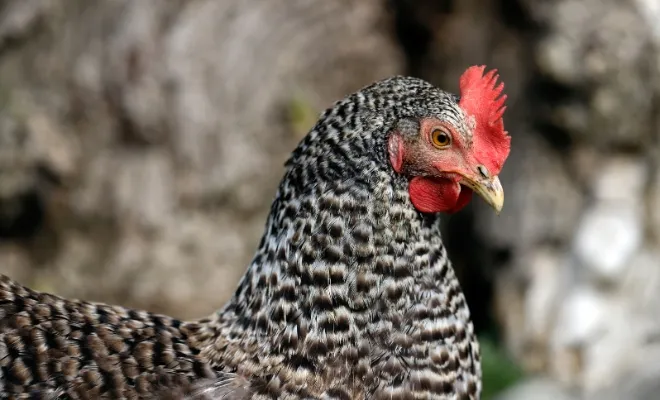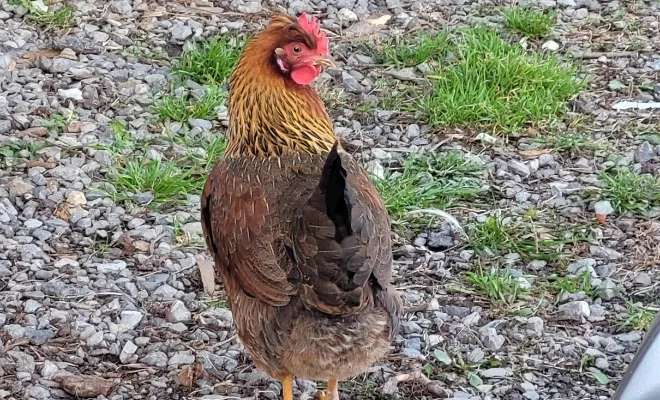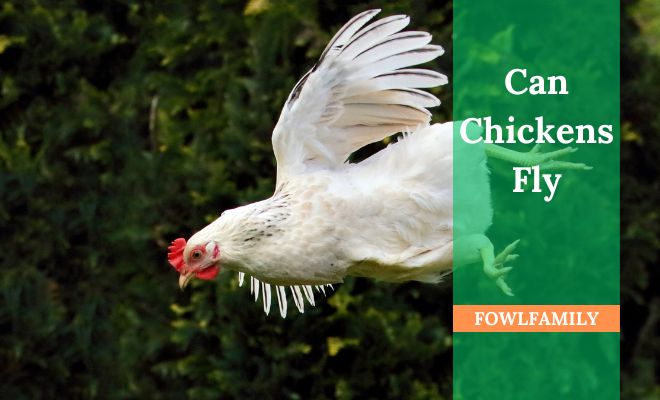Deathlayer Chicken Breed: A Rare Poultry Variety!

Meet the Deathlayer Chicken Breed – a cool bird that’s been around for over 400 years! Despite their scary name, they are a pretty and special chicken from Germany. Originally called “Daudtleijer,” meaning “Long-term Layer,” people started calling them “Totleger,” which means “Deathlayer.”
These chickens have awesome features, like shiny golden feathers, a cool comb on their heads, and serious-looking black eyes. The girl chickens (hens) weigh about 4 pounds, and the boy chickens (roosters) weigh about 5 pounds.
But what’s really neat about them is that they’re great at laying eggs – around 150 to 250 medium-sized white eggs every year! Plus, they’re tough and can handle both hot and cold weather. Join us to learn more about the fascinating Deathlayer chicken and their rich history!
Table of Contents
Deathlayer Chicken Breed Characteristics: A Quick Overview
Here is a quick overview just before the details about the Death Layer Chicken Breed.
| Category | Information |
|---|---|
| Breed Name | Westfälische Totleger |
| Origin | Germany |
| Primary Purpose | Egg Production |
| Average Size | Hens: 4 pounds Around |
| Roosters: 5 pounds Around | |
| Egg Produced Per Year | 150 to 250 per year |
| Egg Color | White (medium-sized) |
| Hardiness | Cold and Heat Hardy |
| Temperament | Nervous, active |
| Lifespan | 10 to 12 years |
| Color Varieties | Gold and Silver |
| Conservation Status | Critically Endangered |
What Is the History and Location of the DeathLayer Chicken Breed?

The Deathlayer chicken, also known as Westfälische Totleger, is a captivating breed with a history spanning over 400 years.
The roots of the Deathlayer chicken can be traced back to Germany. They were named Westfälische Totleger, which translates to “Westphalian Deathlayer” in German.
Although much of their history remains shrouded in mystery, it is believed that this breed has been around for centuries.
Breed’s name has two theories
- Some say they earned the name because of their prolific egg-laying ability. Death Layers are known to lay an egg almost every day until their demise.
- Another theory suggests that the breed was initially called “Daudtleijer” in Low German, which means “Long-term Layer”. Over time, variations in pronunciation led to the evolution of the name to “Totleger”, meaning “Deathlayer.”
Historical documents indicate that Totleger chickens originated from the cities of Bielefeld and Herford in Germany. Back then, they were known as “everyday layers” due to their consistent egg production.
What Defines the Striking Physical Appearance of Death Layer Chickens?

The Deathlayer chicken looks unique and captivating because of their special appearance. Let’s check out the main things that make them look so interesting:
Male (Cock)
- Size: Roosters are generally larger and more robust than hens.
- Plumage: Their feathers exhibit a mix of colors, including black, gold, and copper.
- Comb: The male Deathlayer typically has a single comb that stands upright. They can be quite striking, especially when they contrast with the golden hackle.
- Tail: Their tail feathers are long and well-defined.
- Behavior: Roosters tend to be more assertive and may exhibit protective behavior.
Female (Hen)
- Size: Hens are slightly smaller and more compact.
- Plumage: Their feathers are similar in color but may have a more subtle golden hue.
- Comb: Hens also have a single comb, but they are usually smaller and less pronounced.
- Tail: Their tail feathers are shorter compared to the roosters.
- Temperament: They are generally calmer and less aggressive than roosters.
What Defines the Personality Traits of the Deathlayer Chicken Breed?
The Deathlayer chicken is a special type of chicken that can handle both hot and cold weather. They have interesting behaviors too!
- Nervous and Active: These chickens have a nervous and active temperament. They prefer to keep to themselves rather than interact extensively with humans.
- Foragers and Roamers: Deathlayers love to forage and roam, displaying their energetic nature. They prefer roosting in trees rather than indoor coops, emphasizing their independent streak.
- Tolerant of Climate: While they tolerate both hot and cold climates, they thrive best in living spaces with plenty of room.
Related Articles:
- Isa Brown Chicken: The Perfect Poultry for Beginners!
- Amberlink Chicken With 3 Commercial Backlogs
- Golden-laced Wyandotte Chickens As A Prolific Egg-layer
- Are Yokohama Chickens Right for You? Find Out!
Reproduction and Breeding of DeathLayer Chicken Breed

DeathLayer Chickens, known for their distinctive characteristics and prolific egg-laying abilities, go through a fascinating reproductive journey. Here’s a closer look at their reproduction and breeding process:
When do Death Layer Chickens start having babies?
Death Layer Chickens typically reach sexual maturity at around 5 to 6 months of age. Once they mature, they start laying eggs consistently.
When do the baby chicks hatch?
After mating, Death Layer hens lay fertilized eggs. These eggs take approximately 21 days to hatch. During this incubation period, the hen diligently sits on her clutch of eggs, keeping them warm and ensuring proper development.
How many eggs do they lay?
Death Layer Chickens are exceptional egg producers. On average, a healthy Death Layer hen can lay around 250 to 300 large brown eggs per year. Their consistent egg production makes them a popular choice for backyard flocks and small-scale egg farming.
What color are the eggs?
The eggs laid by Death Layer Chickens have a beautiful rich brown color. The hue can vary slightly, but they generally fall within the warm brown spectrum.
If you’d like to delve deeper into Deathlayer chicken, check out this informative video on Deathlayer Chicken breeding:
11 Ideas to Successfully Breed Deathlayer Chicken Breed
Breed Death Layer chickens by understanding genetics, choosing the right ones, and providing a suitable environment for optimal breeding conditions.
1. Choose the healthy DeathLayer Chickens
Begin by choosing healthy DeathLayer chickens as your breeding stock. Look for birds with vibrant plumage, clear eyes, and strong legs. Avoid any signs of illness or weakness.
2. Breeding Pair
Ideally, you’ll want a rooster and several hens for successful breeding. The rooster’s role is crucial in fertilizing the eggs.
Observe their behavior and compatibility. A harmonious pair will lead to better breeding results.
3. Housing and Space
Provide a spacious and secure coop for your Deathlayers. They need room to move, roost, and lay eggs comfortably. Ensure proper ventilation and cleanliness to prevent diseases.
4. Nutrition
A balanced diet is essential for healthy breeding. Feed your chickens high-quality layer pellets, supplemented with fresh greens, grains, and protein.
Adequate calcium is crucial for eggshell formation, so consider offering crushed oyster shells.
5. Egg Collection

Death Layers are prolific layers. Collect eggs promptly to prevent them from getting damaged or chilled.
Label each egg with the date to track the freshness.
6. Incubation
You have two options: natural incubation (letting the hens sit on the eggs) or artificial incubation using an incubator. If using natural incubation, ensure a quiet, secluded spot for brooding.
7. Candling
Around day 7, candle the eggs to check for fertility. A fertile egg will show veins and a developing embryo.
Remove any infertile or damaged eggs.
8. Hatching
If using natural incubation, let the hen continue sitting until the chicks hatch. In an incubator, maintain proper temperature and humidity levels.
Chicks usually hatch around day 21.
9. Chick Care
Once hatched, provide a warm, safe environment for the chicks. Feed them chick starter feed and ensure they have access to clean water.
10. Raising the Chicks
As the chicks grow, gradually transition them to regular layer feed. Socialize them with other chickens to prevent aggression.
11. Record Keeping
Maintain detailed records of breeding dates, hatch rates, and any health issues. This information will help you improve your breeding program over time.
If you have questions, ask someone who knows about Deathlayer Chicken or see discussions. Taking care of ducks is easy when you have help from friends who know a lot about them.
What Are the Pros and Cons of Choosing DeathLayer Chicken Breed?

Check out the positives – they lay many eggs and have a unique appearance. However, be aware of challenges like lower popularity and nervousness.
Pros of Death Layer
- Lots of Eggs: Deathlayers lay loads of white eggs – about 150 to 250 every year. If you want fresh eggs often, they’re a great pick.
- Fancy Looks: These chickens are like living art! Shiny gold feathers, a cute comb, and black eyes make Deathlayers stand out in any group.
- Tough Chickens: Deathlayers are like superheroes – they can handle hot and cold weather like champs.
- Save the Day: By raising Deathlayers, you’re actually helping to save them. They’re in danger, so having them in your backyard is like being a chicken superhero.
Cons oF Death Layer
- Nervous Chickens: These chickens can be a bit jumpy and need lots of space to be happy. Small spaces might stress them out.
- Rare and Pricey: Because they’re not common, Deathlayers can be a bit expensive. But if you get a pair, you could have egg-laying buddies for a long time.
- Not Super Popular: Back in the 1800s, Deathlayers were like the cool kids, but now they’re not as famous as other chicken breeds.
Final Words
The Deathlayer Chicken Breed is a special kind of chicken that has been around for 400 years. They come from Germany and have unique qualities that make them interesting. This chicken is really good at laying eggs, has distinct physical features, and can live in different kinds of weather.
Even though their name has changed over time, they still have a strong connection to places in Germany. They are tough chickens, but they are also at risk of disappearing.






